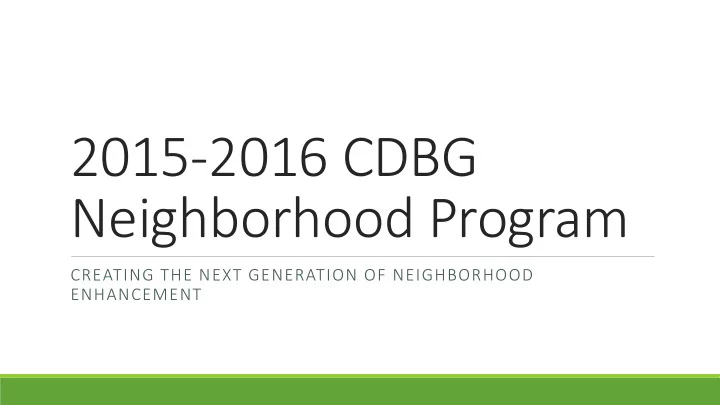

2015-2016 CDBG Neighborhood Program CREATING THE NEXT GENERATION OF NEIGHBORHOOD ENHANCEMENT
CDBG Basics • Community Development Block Grant (CDBG) is a Federal program managed by the Housing & Urban Development department (HUD) • CDBG dollars are intended to provide communities with resources to address unique, local development needs and are primarily required to serve low and moderate income individuals • The City of Spokane receives approximately $3 Million of CDBG funding annually • CDBG funding and all other federal, state and local funding (annual total $13M) that supports services and housing in our community is managed by the Community Housing and Human Services (CHHS) department and citizen advisory board.
CDBG Basics • For all CDBG expenditures, we must show that the expenditure was an “eligible activity” and that it met a “national objective” • There are many eligible activities including: • Housing rehabilitation • Public improvements to parks and infrastructure • Economic development (small business loans, streetscape enhancements, job creation) • Code Enforcement • There are three national objectives : • Low and moderate income benefit (80% or less of Area Median Income) • Prevention or elimination of slums or blight (must be formally identified blighted area) • Urgent need that poses a serious and immediate threat to community health or welfare (e.g. flood or earthquake)
Background • Beginning in the 1970’s the City began allocation a portion of overall CDBG funding to neighborhoods consisting of 51% or greater low and moderate income households. • Neighborhood were identified using 10-year Census income data • Remaining CDBG funds were allocated city-wide by a citizen advisory board • In 2008, the Federal Government began collecting income data through the annual American Community Survey (ACS) instead of the 10-year Census • In late 2013, HUD notified the City of Spokane that ACS income data would be used in place of 10-year Census data for the CDBG program
Why does this matter? • The data generated through the ACS is less specific than US Census data and relies on a smaller sample size (1-40 households) • Due to the smaller sample size, the data is only considered valid down to a block group level and block group level data is more likely to change from year to year • Without the more specific US Census data, the City can no longer use the same methodology for allocating CDBG funds to the 13 traditional CDBG neighborhoods (e.g. using Census data the City was able to split block groups while maintaining data integrity)
CDBG Neighborhood Taskforce • The Community Assembly, Neighborhood Councils and CDBG steering committees were invited to take part in a taskforce to develop recommendations for adapting the CDBG neighborhood program to the changing federal requirements • The taskforce met between February and April of 2014 with over 21 neighborhood represented • The taskforce considered multiple options for adapting the CDBG neighborhood program and made a recommendation to the City and CHHS board to make changes incrementally over a period of two years • Read the taskforce blog for more information at www.spokaneneighborhoods.org • Task force recommendations were adopted by the Community Assembly and the CHHS board • The Community Assembly formed the CA/CD Committee to develop guidelines for the 2015 CDBG Neighborhood Program
2015 Program – Direct Allocation Model • Neighborhood CDBG programs received the same level of funding in 2015 as has been historically provided as a total percentage of CDBG funding received • Single Family Home Rehabilitation Program (15 percent or $630K) • Sidewalk improvement program (12 Percent or $460K) • Neighborhood projects/community, housing and economic development (CHED) (8 Percent or $266K) • Level of neighborhood funding determined through a formula that weighs number of low income individuals and number of block groups with a majority low income families. • Each neighborhood makes individual decisions about the projects they want to fund.
2016 CDBG Neighborhood Program Timeline CNS WORKS TO DEVELOP AND CA/CD COMMITTEE BEGINS WORK IMPLEMENT PROGRAM ON 2016 CDBG PROGRAM CHHS BOARD ADOPTS MATERIALS/TRAINING NEIGHBORHOOD PROJECT OPPORTUNITIES CA/CD COMMITTEE ALLOCATIONS RECOMMENDATIONS PRESENTED TO CA NEIGHBORHOOD APPLICATIONS/DECISIONS DEADLINE 12/7/2014 3/6/2015 4/3/2015 4/5/2015 - 6/1/2015 - 11/1/2015 12/9/2015 7/1/2016 11/30/2015 11/30/15 CA VOTES ON CA/CD PROPOSAL NEIGHBORHOODS WORK TO 2016 CDBG PROGRAM YEAR DECIDE WHICH PROJECTS ARE BEGINS FUNDED
Recommend
More recommend